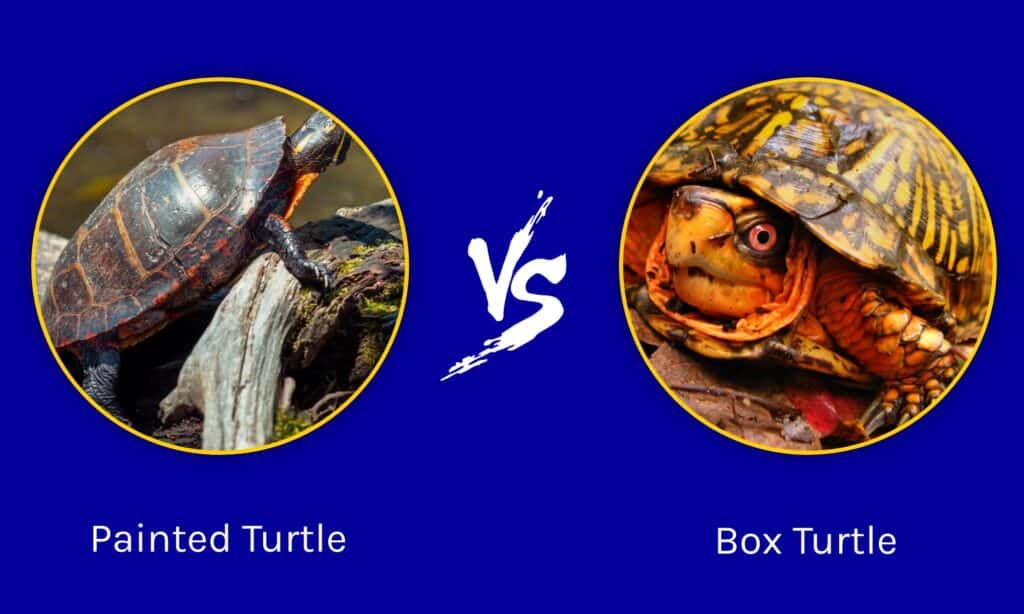Painted turtle vs box turtle, who lives longer?
Box turtles usually live for 25-35 years. However, certain species, like the Yucatan box turtle, can become centurions. Painted turtles don’t live quite that long. While 20-30 years is the norm, sometimes they make it past 50 years.
And their age differences is just the start of what separates these two types of turtles. Read along as we dive into what makes painted and box turtles different.
Comparing Painted Turtle vs Box Turtle

| Painted Turtle | Box Turtle | |
|---|---|---|
| Coloration and Patterns | Dark olive brown body Yellow and yellow-orange bands Thin yellow stripes on head Thin red stripes on neck and tail Black head with yellow spots behind eyes | High domed shell Varied colorations Yellow and orange splotches Dark brown plastron |
| Winter Survival Techniques | Will stay in freezing North American waters Breathes underwater with cloacal respiration | Stays on land during winter Burrows into soil Enters brumation (a type of hibernation) |
| Ecological Challenges | Invasive red-eared sliders | Poachers for turtle market |
Painted Turtle vs Box Turtle: Key Differences Explained

Painted turtles have yellow spots behind their eyes.
©Sketchart/Shutterstock.com
The key differences between a painted turtle and box turtle include their coloration, wintering behaviors, and ecological challenges. Painted turtles earn their name with vivid markings throughout their body. Comparatively, box turtles earned their reputation with a special hinge that helps them hide away inside their domed shell.
During the winter months, painted turtles use their cloaca for underwater butt-breathing. Box turtles prefer burrowing in the soil to wait out the cold months.
Regarding ecological threats, painted turtles in New York City are having issues. In contrast, box turtles in Florida are on the run from poachers. Keep reading as we dive deeper into the lives of painted turtles vs box turtles.
Painted Turtle vs Box Turtle: Coloration and Pattern

Box turtles have high domed shells.
©iStock.com/SteveByland
Painted turtles have a medium to dark olive brown color. Their plural scutes usually align; however, the seams can be misaligned in some. Along the seams, you’ll find bands of yellow to yellowish orange colors.
The painted turtle’s head is black, with attractive yellow spots behind its oval eyes. There are also thin yellow stripes on their head right below their eyes and chin.
Painted turtles continue to earn their name by being painted with narrow red stripes on their neck. Their tail is dark brown or black and has thin red stripes and dashes. Their limbs are the same coloration as their tail.
Regarding the painted turtle’s pattern, you’ll notice that the marginals have a slight pattern on each side. The turtle’s plastron (belly) is usually unpatterned; however, some painted turtles have dark figures. The dark figures can vary and design, usually right along the midline.
Box turtles have a high domed shell they can hide inside like a box. It’s all thanks to a special plastron hinge they use. The plastron is usually a dark brown color. They also have an interesting coloration with yellow and orange splotches.
As they age, the box turtles’ carapace pattern becomes less noticeable. On their hind feet, they have four toes, and the males usually have red eyes. Another way to tell the males apart from the female is by looking at their tails. The males tend to have shorter, thicker, and generally larger tails than the females.
Painted Turtle vs Box Turtle: Winter Survival Tactics

Painted turtles use cloacal respiration to stay immersed in freezing waters.
©Kris Wiktor/Shutterstock.com
Turtles don’t age the same way as other living creatures. Each species has independently evolved strategies for surviving harsh weather and other challenges.
Painted turtles thrive in North American ponds. When the temperatures change from summer to winter, the turtles have a unique way of adapting. If their favorite watering holes become covered by ice, the turtles will lower their body temperatures too. They can also slow their metabolism by as much as 95%.
However, even with these changes, they still need oxygen. Typically, painted turtles breathe with their lungs. But when they can’t get to the surface for air, they get the limited oxygen they need through cloacal respiration–breathing through their butts.
A lot of reptiles have a cloaca. It’s an orifice that helps with a lot of things, and in this case, underwater breathing. Blood vessels bordering the cloaca absorb oxygen from the surrounding water. The idea of turtles hibernating and breathing through their butts is hilarious and mind-boggling.
Box turtles, like many reptiles, have also evolved to deal with bone-chilling weather. They’ll hibernate in burrows made from soft soil and leaf litter covers for about 142 days.
The hibernation, or “brumation,” gives the box turtles a chance to cool down and enter into a state of inactivity. They use stored fat to survive. Even though their metabolism is slow, they can move if necessary.
It’s incredible how the box turtle knows when to start brumation in the fall. Scientists believe soil and air temperatures and day lengths give them the cue.
Box turtles amaze us when they instinctively know to emerge in the spring too. Deep within their burrow, there isn’t any light, so how do they know it’s time to come out? It’s still a mystery.
Painted Turtle vs Box Turtle: Current Ecological Threats

Red-eared sliders are invading New York City waterways.
©xbrchx/Shutterstock.com
In New York City, painted turtles and many other native turtle species have issues with red-eared sliders. Eastern painted turtles are the most common species throughout New York. However, their numbers are rapidly declining.
Red-eared sliders are invasive species adapted well to life in New York City ponds. Since they’re opportunistic feeders, they can easily out-eat other turtle species.
Painted turtles, bog turtles, spotted turtles, and musk turtles used to have a perfect balance in New York’s waters. Now, competition with red-eared sliders for space and food is affecting the native populations.
Central Park used to be full of painted turtles, and now it’s rare to see one. What’s the solution to the painted turtle problem?
Educating pet owners about responsible ownership. The more people understand invasive species, the easier it’ll be to prevent them from happening again.
Box turtles are facing a different type of problem. Poachers are targeting them for the turtle market. The entire population can collapse rapidly when large numbers are removed from one location.
Two poachers caught by the Florida Fish and Wildlife Conservation Commission had already removed 4,000 turtles in six months. Wild turtle populations can’t sustain that type of harvest.
Thankfully conservationists are working hard to help the turtles survive commercial exploitation. Animal lovers are helping too by inspiring others to learn about different turtle species’ needs.
All it takes is one fascinating animal fact to make you hungry for more. Like how it makes you feel discovering there are 100-pound alligator snapping turtles in the Mississippi. Crazy? Yes, but also true.
The photo featured at the top of this post is ©
Thank you for reading! Have some feedback for us? Contact the AZ Animals editorial team.






